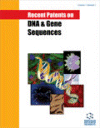- Home
- A-Z Publications
- Recent Patents on DNA & Gene Sequences (Discontinued)
- Previous Issues
- Volume 7, Issue 1, 2013
Recent Patents on DNA & Gene Sequences (Discontinued) - Volume 7, Issue 1, 2013
Volume 7, Issue 1, 2013
-
-
Genetic Improvement of Biofuel Plants: Recent Progress and Patents
More LessDue to depleting reserves of fossil fuels, political uncertainties, increase in demand of energy needs and growing concerns of environmental effects, bioenergy as an alternative source of energy needs had taken centre stage globally. In this report, we review the progress made in lignocellulose, cellulose and fermentation based biofuels in addition to tree borne oil seeds. Algae as a source of feedstock for the biofu Read More
-
-
-
Development of Energy Plants and their Potential to Withstand Various Extreme Environments
More LessAuthors: Walid Saibi, Faical Brini, Moez Hanin and Khaled MasmoudiBiomass utilization is increasingly considered as a practical way for sustainable energy supply and long-term environment care around the world. In concerns with food security, starch or sugar-based bioethanol and edible-oilderived biodiesel are severely restricted for large scale production. Alternatively, conversion of lignocellulosic residues from food crops could be considered, but due to its recalcitrance, the current biomas Read More
-
-
-
Recent Patents on Genetic Modification of Plants and Microbes for Biomass Conversion to Biofuels
More LessAuthors: Simona Lubieniechi, Thinesh Peranantham and David B. LevinDevelopment of sustainable energy systems based on renewable biomass feedstocks is now a global effort. Lignocellulosic biomass contains polymers of cellulose, hemicellulose, and lignin, bound together in a complex structure. Liquid biofuels, such as ethanol, can be made from biomass via fermentation of sugars derived from the cellulose and hemicellulose within lignocellulosic materials, but pre-treatment of the biomas Read More
-
-
-
Genetic Improvement of Plants for Enhanced Bio-Ethanol Production
More LessAuthors: Sanghamitra Saha and Srinivasan RamachandranThe present world energy situation urgently requires exploring and developing alternate, sustainable sources for fuel. Biofuels have proven to be an effective energy source but more needs to be produced to meet energy goals. Whereas first generation biofuels derived from mainly corn and sugarcane continue to be used and produced, the contentious debate between “feedstock versus foodstock” continues. The need for so Read More
-
-
-
Functional Genomics of Bio-Energy Plants and Related Patent Activities
More LessAuthors: Shu-Ye Jiang and Srinivasan RamachandranWith dwindling fossil oil resources and increased economic growth of many developing countries due to globalization, energy driven from an alternative source such as bio-energy in a sustainable fashion is the need of the hour. However, production of energy from biological source is relatively expensive due to low starch and sugar contents of bioenergy plants leading to lower oil yield and reduced quality along with lo Read More
-
-
-
Advances in the Management of Malignant Hemopathies: The Role of Statins
More LessToday, hematology is dependent on molecular biology for diagnosis, establishing the prognosis and treatment guidance in more and more diseases. One useful technique in this respect is the gene expression profiling, whose use is not yet a matter of routine. The discovery that the expression of LDL-receptor and cholesterol synthesis is increased in the cells of some leukemias and lymphomas and that some statins induced DNA d Read More
-
-
-
Licensed DNA Vaccines against Infectious Hematopoietic Necrosis Virus (IHNV)
More LessAuthors: Marta Alonso and Jo-Ann C. LeongThis article reviews some of the recent patents on DNA vaccines against fish viruses, in particular against the novirhabdovirus infectious hematopoitic necrosis virus (IHNV). Although very effective in protecting fish against IHNV, only one DNA vaccine has been approved to date for use in Canada. In Europe and in US, its commercialization is restricted due to safety concerns.
-
-
-
Recent Patents on Bacteriocins: Food and Biomedical Applications
More LessMost types of bacteria produce bacteriocins, which are proteinaceous extracellular compounds that can inhibit the growth of other undesirable microorganisms. Bacteriocins are receiving increasing attention, due to their many applications, ranging from their initial application in strategies for food preservation to more recent proposed uses in biomedical strategies aimed at fighting certain bacterial infections. Thus, while ni Read More
-
-
-
Recent Patents Concerning Modulators of Protein Kinase C
More LessAuthors: Sonia Sanchez-Bautista and Francisco E. NicolasProtein kinase C (PKC) comprises a family of 10 serine/threonine kinases divided into 3 subfamilies: classical, novel and atypical. These isoenzymes represent one of the major mediators of signal transduction, and most may be associated with several pathogenic processes including malignant transformation or cancer and metastasis. Moreover, some activated isoenzymes are also involved in other diseases such as infarct, reje Read More
-
Most Read This Month
Article
content/journals/dnag
Journal
10
5
false
en


